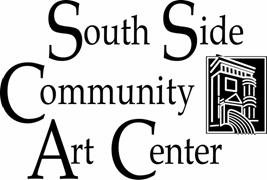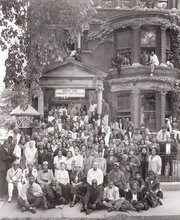In front of us, nestled between an empty lot and a barbeque business, around the corner from a liquor store and across the street from a pink hotel, stood a regal looking weathered brick structure with a thriving old ivy plant covering two-thirds of its north side. This was our long awaited destination. The famed Bronzeville South Side Community Art Center (SSCA) of Chicago.
The institution’s curator invited us to Chicago to exhibit our artwork in this revered institution; and also to give us the flavor of Chicago’s African-American art community. With driving skills that would challenge a New York taxi driver during rush hour, he bobbed and weaved his head like a boxer while zigzagging his vehicle through Chicago traffic. The two day art excursion included two private collections, the studio of a world renowned artist, several galleries, and an art fair where he was bombarded with questions about community art activities. This is where we met artists who talked about black cultural regeneration …a “renaissance”. They say this new Chicago Bronzeville art movement seems to be in evidence with the purchase of artwork by community people. They also contend that this response reveals enthusiasm similar to those expressed during the Harlem Renaissance some 87 years ago.
After stepping from the vehicle, my wife, Rose, and I, couldn’t help but notice a gathering of several black men in the lot behind the Center. Seated on metal buckets, wooden boxes, and old rickety chairs, they seemed to be holding their weekly backyard summit on “world affairs”. Since this was Saturday, and the middle of a traditional African-American community, one should be familiar with this community tradition.
When our focus returned to the 1892 Georgian Revival-architectural style building, I noticed that the structure, sitting in the middle of a small lawn next a surreal looking rust colored sculpture piece, was not tattooed with graffiti, or any kind of desecration; because this institution is considered a sacred place worthy of religious veneration.
After stepping through the two sets of plate glass wooden double doors, you enter a small room with the smell of age. By the right side of the double doors hangs an array of photos that includes the 1941 dedication by First Lady Eleanor Roosevelt; and other luminaries such as Gordon Parks, Charles White, Gwendolyn Brooks, Elizabeth Catlett and others. These photos represent a long list of renowned artists who have given their time and talents to this institution. Facing the pictures is a counter topped with pamphlets, exhibition post cards, and information about the scheduled Center events.
Looking straight ahead, there is a steep narrow staircase that leads to the second floor. Just before reaching the stairway, off to your right, a large open doorway leads to the main gallery area. The gallery is named after Dr. Margaret Burroughs, the revered community educator.
History will inform you that this place, situated in the heart of Bronzeville, grew out of the Works Progress Administration (WPA) Federal Arts Projects that was established during the presidential administration of Franklin D. Roosevelt. The Center’s doors opened in 1940 to artists, art lovers and the community. It was dedicated in 1941 by First Lady Eleanor Roosevelt. Classes were held and exhibitions installed giving African-American artists opportunities they never had before. In 1943, WPA funding was withdrawn and community art centers around the county closed their doors, except for one. Of the 100 community art centers established under the WPA auspices, the SSCAC’s doors stayed open and it is the only continuous operating survivor today, thanks to a coalition of artists and supporters.
When you step inside the Burroughs Gallery, a tall, loose-limbed, athletic looking man greets you; his shoulders are very broad; his off white shirt opened from his thick cord neck; his chest showed, full; his handshake possessed a vice grip and was huge, strong and brown; his loose fitting clothing failed entirely to conceal his bulging muscles; his hair with short tight curls that were firmly fixed about a countenance that possessed warm penetrating eyes of compassionate hope, while emptying waste baskets and arranging food and refreshments for the exhibition.
Hair curls nor compassionate eyes could not blot out a suggestion of alert strength that came from every line in his figure; he was a man driven by a mission. Bustling of gait and compassionate speech with a face as innocent as a choir boy’s, he has energized the SSCAC. His name is Faheem Majeed. Majeed is an artist who dedicated his efforts four years ago to help the flagging SSCAC.
In his keenly sensitive, genius state of imagination, Majeed suddenly became aware of a fact fraught with possibilities…the establishment of the SSCAC as a museum.
You will find Majeed to be a very proud and dedicated individual with a mission to establish a major art museum. After spending two days with this young man, you too would be certain that his devotion to duty, steadfast determination, and eloquent style of communicating will bring about wide recognition and special distinction for this historic institution. It is evident that he has given to the operation a clear, intelligent and consistent moral purpose. His vision and concern for others will be a living illustration of what can be achieved with integrity and professionalism.
- Melvin Smith
Thursday, August 9, 2007
Wednesday, August 8, 2007
In Search of Validation
When the curatorial director, Faheem Majeed, invited my wife, Rose J. Smith, and myself, Melvin R. Smith, to exhibit our artwork in the Bronzeville area South Side Community Art Center, we were thrilled. In exhibiting our work in the same place that African-American art luminaries such as Archibald Motley, Charles White, Gordon Parks, and Elizabeth Catlett have is a crowning achievement for us.
We have never had the opportunity to show our work in the two traditional major African-American cultural centers such as the Bronzeville South Side areas of Chicago or the Studio Museum in Harlem, New York. Our New York exhibitions were in midtown on 57th Street, Central Park West, and Broadway.
History has informed us that Harlem, New York, and the South Side of Chicago have been the fertile sources, touchstones, and nurturers of African-American culture. As artists, we are in search of what William H. Johnson, Romare Bearden, Jacob Lawrence, Charles White, Archibald Motley, and Elizabeth Catlett have received from these two African-American communities...."validation".
As the ultimate African-American communities, they served to reveal these artists for what they were ...transcenders of the culture. It was from within these communities where they have gained authority and, in a circle of validation, were in empowered by the authentic culture from whence they came. The culture's values and inventions are being celebrated in excellent fashion by the art that these artists have since produced.
Therfore, we consider our exhibition at the South Side Community Art Center to be a singal event, an act of bearing witness. It is, in the tradition of the African American culture, a homecoming in search of validation.
- Melvin R. Smith
We have never had the opportunity to show our work in the two traditional major African-American cultural centers such as the Bronzeville South Side areas of Chicago or the Studio Museum in Harlem, New York. Our New York exhibitions were in midtown on 57th Street, Central Park West, and Broadway.
History has informed us that Harlem, New York, and the South Side of Chicago have been the fertile sources, touchstones, and nurturers of African-American culture. As artists, we are in search of what William H. Johnson, Romare Bearden, Jacob Lawrence, Charles White, Archibald Motley, and Elizabeth Catlett have received from these two African-American communities...."validation".
As the ultimate African-American communities, they served to reveal these artists for what they were ...transcenders of the culture. It was from within these communities where they have gained authority and, in a circle of validation, were in empowered by the authentic culture from whence they came. The culture's values and inventions are being celebrated in excellent fashion by the art that these artists have since produced.
Therfore, we consider our exhibition at the South Side Community Art Center to be a singal event, an act of bearing witness. It is, in the tradition of the African American culture, a homecoming in search of validation.
- Melvin R. Smith
Subscribe to:
Posts (Atom)

